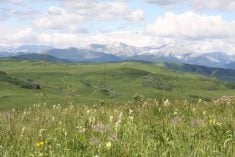A tiny pest could produce a giant headache for many Saskatchewan wheat growers in 2008.
A major infestation of wheat midge is being forecast for the province this year, encompassing a significant swath of the wheat growing region.
A map released by the provincial agriculture ministry last week shows a sea of red, indicating severe infestation, north of a line running diagonally across the province from Moosomin in the southeast to Kerrobert in the west.
“This is the largest area of severe infestation that I think I’ve ever seen,” said Scott Hartley, insect management specialist for the ministry.
Read Also

VIDEO: Case IH reveals new Optum tractor at Agritechnica 2025
Case IH reveals its new Optum tractor at Agritechnica 2025.
Usually the map shows a number of isolated hot spots, but for 2008 it shows an almost uninterrupted, contiguous area of severe infestation.
“It’s not a pretty picture,” Canadian Wheat Board agronomist Mike Grenier told producers attending a recent CWB meeting in Saskatoon.
“Farmers need to be concerned and vigilant (because) it’s going to be a real big problem in 2008.”
The area most at risk coincides roughly with the moist dark brown, black and grey soil zones.
Hartley said conditions in the past two years have been ideal for wheat midge, which thrives in moist conditions.
The midge population declined in the early 2000s after several hot, dry years, but in recent years heavy snow cover and good or excessive moisture levels in the spring and fall have created an ideal environment for the voracious wheat-eating insect.
Conversely, a parasitic wasp that provides natural control prefers hot, dry conditions. In other words, when the midge population is high, the wasp population is low and vice versa.
While the map provides an indication of the midge threat, farmers are advised to monitor their wheat fields during the susceptible period – from when the wheat head emerges as the boot splits until mid-flowering.
Midges appear in late June in the south and continue until mid-July, depending on temperature and crop development.
Hartley said fields should be monitored regularly to determine whether the midge population is increasing or decreasing and whether chemical controls should be applied.
“Timing is critical and therefore proper monitoring is very important.”
Yields are generally reduced by 10 to 15 percent when the midge population is one adult insect per four or five heads. Quality is at risk when the population is one midge per eight to 10 heads.
Depending on monitoring results, farmers may need to spray with chlorpyrifos or dimethoate when the crop is heading. Later spraying is not cost effective and may harm the parasitic wasps.
Farmers need to calculate the costs and benefits of spraying, depending on the level of infestation, the cost of applying the chemical and the price of wheat.
If the infestation is severe, the best thing might be to switch to a nonsusceptible crop such as barley, oats or winter wheat, assuming it fits in the rotation.
Three new midge resistant varieties are in the registration pipeline – Unity, Goodeve and BW 365 – but they won’t be commercially available until 2009.














